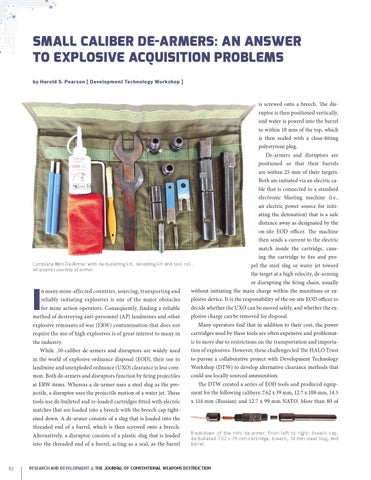SMALL CALIBER DE-ARMERS: AN ANSWER TO EXPLOSIVE ACQUISITION PROBLEMS by Harold S. Pearson [ Development Technology Workshop ]
is screwed onto a breech. The disruptor is then positioned vertically, and water is poured into the barrel to within 10 mm of the top, which is then sealed with a close-fitting polystyrene plug. De-armers and disruptors are positioned so that their barrels are within 25 mm of their targets. Both are initiated via an electric cable that is connected to a standard electronic blasting machine (i.e., an electric power source for initiating the detonation) that is a safe distance away as designated by the on-site EOD officer. The machine then sends a current to the electric match inside the cartridge, causing the cartridge to fire and proComplete Mini De-Armer with de-bulleting kit, reloading kit and tool roll.
pel the steel slug or water jet toward
All graphics courtesy of author.
I
the target at a high velocity, de-arming or disrupting the firing chain, usually
n many mine-affected countries, sourcing, transporting and
without initiating the main charge within the munitions or ex-
reliably initiating explosives is one of the major obstacles
plosive device. It is the responsibility of the on-site EOD officer to
for mine action operators. Consequently, finding a reliable
decide whether the UXO can be moved safely, and whether the ex-
method of destroying anti-personnel (AP) landmines and other
plosive charge can be removed for disposal.
explosive remnants of war (ERW) contamination that does not
Many operators find that in addition to their cost, the power
require the use of high explosives is of great interest to many in
cartridges used by these tools are often expensive and problemat-
the industry.
ic to move due to restrictions on the transportation and importa-
While .50-caliber de-armers and disruptors are widely used
tion of explosives. However, these challenges led The HALO Trust
in the world of explosive ordnance disposal (EOD), their use in
to pursue a collaborative project with Development Technology
landmine and unexploded ordnance (UXO) clearance is less com-
Workshop (DTW) to develop alternative clearance methods that
mon. Both de-armers and disruptors function by firing projectiles
could use locally sourced ammunition.
at ERW items. Whereas a de-armer uses a steel slug as the pro-
The DTW created a series of EOD tools and produced equip-
jectile, a disruptor uses the projectile motion of a water jet. These
ment for the following calibers: 7.62 x 39 mm, 12.7 x 108 mm, 14.5
tools use de-bulleted and re-loaded cartridges fitted with electric
x 114 mm (Russian) and 12.7 x 99 mm NATO. More than 80 of
matches that are loaded into a breech with the breech cap tightened down. A de-armer consists of a slug that is loaded into the threaded end of a barrel, which is then screwed onto a breech. Alternatively, a disruptor consists of a plastic slug that is loaded into the threaded end of a barrel, acting as a seal, as the barrel
62
Breakdown of the mini de-armer. From left to right: breech cap, de-bulleted 7.62 x 39 mm cartridge, breech, 14 mm steel slug, and barrel.
RESEARCH AND DEVELOPMENT @ THE JOURNAL OF CONVENTIONAL WEAPONS DESTRUCTION












